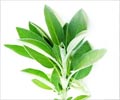About
The name Sage is derived from the Latin word salvere meaning ‘to save’. The herb is a member of the mint family and has many of the healing properties of its sisters.
Sage is a native of the Mediterranean area. It is largely cultivated in Yugoslavia, Italy, Albania, Turkey, Portugal, Spain, Cyprus, England, Canada and USA. In India, it is sparingly cultivated in and around Jammu.
The volatile oils and phytochemicals in sage include thujone, rosmarinic acid, camphor, tannin, flavonoid, estrogenic compounds and cineole. Like other commonly used dried herbs in the kitchen, sage is used for seasoning fish, meat, salads, sandwiches etc.

The popularity of sage can be easily reflected from the fact that in the ancient times, the Chinese used to exchange three cases of tea leaves with the Dutch, for a single case of sage leaves. Sage is a boon in conditions like indigestion, gas, depression and menopausal problems, owing to the nutrients in it. The sage leaf is a great source of nutrients, just like other vegetables.
Nutrition Value
Values given for 2 tsp of sage leaves (1.40 g)
| Nutrient | Amount |
| Protein | 0.16 g |
| Dietary Fiber | 0.56 g |
| Vitamins | |
| Vitamin A IU | 85.56 IU |
| Vitamin A RE | 8.56 RE |
| A- carotenoid | 8.56 RE |
| A- beta carotene | 51.32 mcg |
| Minerals | |
| Calcium | 20.16 mg |
| Iron | 0.40 mg |
| Potassium | 14.00 mg |
| Sodium | 0.16 mg |
Sage is a good source of vitamin A, providing 85.6 IU per 2 teaspoon serving, most of which comes from beta-carotene, an antioxidant best known for eye health. The leaves also contain essential minerals like calcium, iron and potassium. Calcium is an essential nutrient for bone health and calcium and potassium together are important for cardiovascular health. In addition, sage only contains minute amounts of sodium per serving, making it a great addition to a low-sodium diet.
Health Effects of Sage Leaves
Sage has been used to treat a wide range of conditions like cold, sore throat, fever, respiratory problems, sinusitis, skin problems, menstrual disorders, digestive ailments and memory loss. It helps enhance mental functions and boost the immune system.
Menstrual problems
Sage contains phytoestrogens [plant compounds that act like oestrogen] which help to treat menstrual problems. In menopausal women, it provides relief from hot flashes and night sweats. It helps regulate menses and abnormal blood flow.

Infections
Sage contains tannins which are polyphenols that help fight infections and have been used for treating mouth sores, mouth ulcers, infected and bleeding gums, sore throat, tonsillitis, cold and fever.
Inflammatory conditions
Sage contains a phenolic acid called rosmarinic acid. This antioxidant acts to reduce inflammatory responses in the body. Increased intake of sage is recommended in inflammatory conditions such as rheumatoid arthritis, bronchial asthma, and atherosclerosis.
Cancer
Sage is rich in flavonoids like apigenin, diosmetin, and luteoin which help to prevent certain type of cancers.
Brain function
Compounds isolated from an extract from the root of Chinese sage were found to be acetylcholinesterase (AChE) inhibitors, which may have a protective effect against Alzheimer’s disease.
Memory
Studies suggest that sage may improve mood and mental performance in healthy young people and memory and attention in older adults. It has been found to enhance thinking and learning in older adults with mild to moderate Alzheimer’s disease.

Digestion
The herb is a carminative [medicine that prevents formation of gas] and a digestive tonic. Its regular consumption stimulates appetite and aids in smooth functioning of the digestive system. Sage has been used for treating intestinal cramps, flatulence and indigestion.
Type 2 Diabetes patients
Studies have found that the sage leaf is good at lowering cholesterol and triglyceride levels in patients with diabetes type 2.
Cellulite
Sage oil is helpful in reducing cellulite. Since the oil helps in increasing blood circulation, it leads to the breakdown of fat cells and helps in reducing cellulites.
Hair and skin
Massaging with sage oil improves blood circulation and encourages hair growth. It can strengthen weak hair and reduce premature greying. Massaging the skin with sage oil has revitalizing effects. Sage oil also helps to treat many skin problems.

Ways of Using Sage
- Sage is available as dried leaves, liquid extracts and essential oils. Whenever possible one should use fresh leaves instead of dried ones for maximum flavor.
- Sage is most commonly used as a spice or herb (fresh and dry) and lends a sweet, warm and earthy flavor to food.
- It is often used along with herbs like thyme, basil and rosemary.
- Sage leaves are used as a seasoning or even as a marinade. It makes digesting meat easy on the stomach. It can be used as a seasoning to salads, tomato sauce, stir fries, egg dishes. But it should be added only at the end of the cooking process for maximum flavor.
- Sage tea can be prepared by boiling a handful of sage leaves in a cup of water. Drinking sage tea twice daily for a month can help ease symptoms of rheumatoid arthritis and improve health.

 MEDINDIA
MEDINDIA
 Email
Email






